The diets of the people in Fiji, both in the past and present, provide insights into the rich history of Fijian culinary traditions and the importance of traditional foods.
Fijian cuisine has a long and diverse history, shaped by the cultural influences and geographical location of the islands.
Key Takeaways
- The history of food in Fiji is deeply intertwined with the nation’s cultural identity.
- Fijian cuisine has evolved over centuries, incorporating traditional foods that are still cherished today.
- Social changes and identity play an important role in shaping the Fijian food culture.
- Maintaining a healthy diet and promoting traditional foods are crucial for the overall well-being of the Fijian population.
- Mother’s influence in shaping food decisions, especially during festive occasions, is significant in Fijian culture.
Fijian Culinary Evolution
The traditional foods of Fiji have played a significant role in shaping the unique Fijian cuisine, reflecting the rich cultural heritage of the islands. Fijian culinary evolution has been influenced by a combination of indigenous practices, colonial influences, and globalization. These factors have contributed to the development of a diverse and flavorful cuisine that is loved by locals and visitors alike.
Traditional foods in Fiji are deeply rooted in the island’s history and have been passed down through generations. Staples such as taro, cassava, and coconut are commonly used in traditional cooking, providing a foundation for many Fijian dishes.
The use of locally sourced ingredients and traditional cooking methods, such as underground ovens known as lovo, adds depth of flavour and authenticity to Fijian cuisine.
Over time, Fijian cuisine has evolved to incorporate new ingredients and cooking techniques introduced by the colonial powers. Indian, Chinese, and British influences have brought a fusion of flavours and culinary traditions to the Fijian table. The introduction of spices, such as curry powder and turmeric, has added complexity to Fijian dishes and created a unique blend of traditional and international flavours.
Today, Fijian cuisine continues to evolve with the influence of globalization and modern food trends. While traditional foods remain a staple in many households, there is also a growing interest in international cuisines and fusion dishes.
Chefs and home cooks alike are experimenting with new flavours and techniques to create innovative dishes that showcase the diversity of Fijian cuisine.

The rich history and cultural significance of Fijian cuisine make it a vital part of the country’s identity. Whether enjoying a traditional Fijian feast or savouring a fusion dish at a modern restaurant, food in Fiji is a celebration of heritage, community, and a deep connection to the land. Through its culinary evolution, Fijian cuisine continues to delight taste buds and tell the story of this vibrant island nation.
Influence of Social Changes and Identity
The cuisine of Fiji not only reflects the diverse flavours and ingredients of the islands but also serves as an important marker of social changes and national identity.
Throughout history, Fijian food has been influenced by various factors, such as the arrival of different ethnic groups, colonial influences, and globalization. These influences have not only shaped the culinary landscape but have also played a significant role in defining the cultural identity of the Fijian people.
One of the key aspects of Fijian cuisine is its connection to traditional foodways and indigenous ingredients. Traditional Fijian dishes, such as kokoda (marinated fish in coconut milk) and lovo (earth oven-cooked meats and vegetables), are deeply rooted in Fijian culture and are often prepared during special occasions and celebrations. These dishes not only provide nourishment but also serve as a symbol of cultural heritage and pride.
Over the years, however, social changes have influenced the way Fijians perceive and consume food. Globalization and modernization have led to the introduction of processed and imported foods, which have gradually replaced some traditional ingredients and cooking methods.
This shift towards modern food choices has had both positive and negative consequences, as it has provided access to a wider range of options but has also contributed to the challenges of malnutrition and the loss of traditional dietary practices.
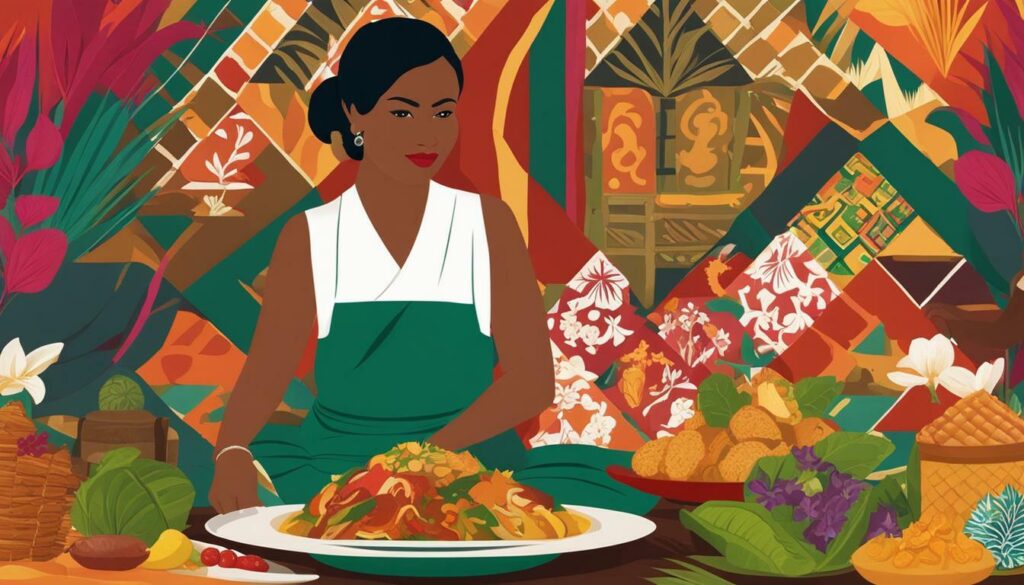
Despite these changes, efforts are being made to preserve and promote Fijian national food as a means of safeguarding cultural heritage and improving the health and well-being of the population. Organizations and individuals are working together to promote the use of indigenous ingredients, support local farmers, and educate the community about the importance of traditional diets.
By embracing both the past and present diets of Fiji, the nation can continue to celebrate its culinary heritage while adapting to the evolving needs and preferences of its people.
| Dish | Description |
|---|---|
| Kokoda | Marinated fish in coconut milk |
| Lovo | Earth oven-cooked meats and vegetables |
| Rourou | Taro leaves cooked in coconut milk |
| Dalo | Taro root served as a side dish |
The traditional Fijian dishes listed in the table are just a few examples of the rich culinary heritage of Fiji. These dishes not only showcase the unique flavours and ingredients of the islands but also represent the traditions and customs that have been passed down through generations.
By preserving and promoting these traditional foods, Fijians can ensure that their cultural identity remains strong and vibrant.
Dietary Behaviors in Fiji
The dietary behaviours in Fiji have undergone significant changes over time, with traditional foods being replaced by modern choices, shaping the current food landscape of the nation. The shift from traditional diets to processed foods has had a profound impact on the health of the Fijian population.
The national dish of Fiji, known as “kokoda,” represents the amalgamation of traditional ingredients and influences from neighbouring cultures. It is a popular and loved dish, showcasing the rich culinary heritage of the country.
Typical foods consumed in Fiji now include a mix of locally produced fruits, vegetables, fish, and imported foods like rice and canned goods.
The table below presents some of the most common traditional foods of Fiji:
| Food | Description |
|---|---|
| Taro | A starchy root vegetable, often boiled or roasted and served with fish or meat. |
| Kumala | Sweet potato, can be cooked in various ways, such as boiling, frying, or baking. |
| Dalo | A type of taro, commonly cooked and mashed to make “palusami,” a dish wrapped in taro leaves with coconut milk and baked. |
| Kokoda | A traditional Fijian ceviche-style dish made with raw fish marinated in coconut cream and lime juice, mixed with vegetables. |
“The Fijian diet has evolved over time, influenced by cultural exchanges and historical events. While traditional foods are still cherished and enjoyed, globalization and urbanization have brought about shifts in dietary preferences and habits.”
The introduction of processed foods has contributed to the rise of non-communicable diseases in Fiji, such as obesity, diabetes, and cardiovascular diseases. The availability and affordability of fast food and sugary drinks have led to an increased consumption of unhealthy choices. The challenge of malnutrition continues to persist, with both undernutrition and overweight/obesity prevalent in different segments of the population.
To address these issues, it is crucial to promote healthful nutrition in Fiji. This involves preserving and promoting traditional foods, educating the population about the importance of a balanced diet, and encouraging the consumption of locally sourced, fresh ingredients. By embracing the cultural significance of Fijian cuisine and incorporating traditional recipes into modern menus, the nation can work towards improving the overall health and well-being of its people for generations to come.
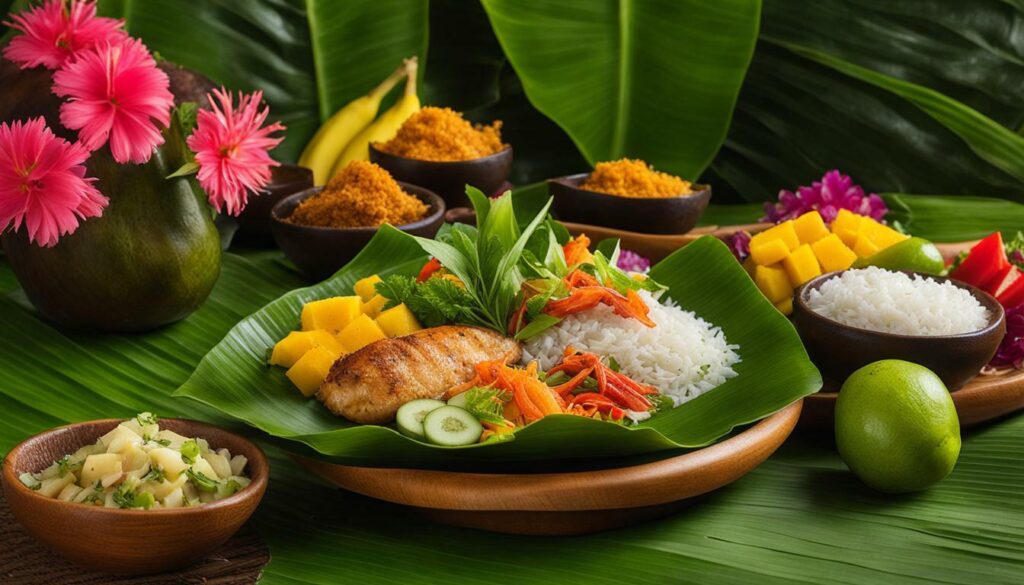
Challenges of Malnutrition
The shift from traditional Fijian meals to unhealthy food options has contributed to the multiple burdens of malnutrition in the Fijian population, highlighting the importance of preserving and promoting traditional recipes.
Traditional Fijian meals, rich in fresh fruits, vegetables, and seafood, provided a balanced diet that sustained the health of the community for generations. However, with the impact of globalization and the introduction of processed and fast foods, the dietary habits of the Fijian people have undergone a significant transformation.
The increasing consumption of sugary beverages, processed snacks, and fast food has led to a rise in chronic diseases such as obesity, diabetes, and cardiovascular illnesses. These shifts in dietary patterns have not only affected physical health but also contributed to the loss of cultural heritage and identity.
Traditional Fijian recipes passed down through generations, are at risk of being forgotten as the younger generation becomes more exposed to Westernized food choices.
Addressing the challenges of malnutrition requires a holistic approach that recognizes the importance of cultural preservation and health promotion. Efforts should be made to educate the population about the nutritional value of traditional Fijian meals and the benefits of incorporating them into their daily diets. By promoting local, fresh, and seasonal ingredients, communities can reestablish their connection with traditional foods and revive cultural practices.
| Traditional Fijian Dish | Description |
|---|---|
| Kokoda | A popular Fijian dish made with raw fish, marinated in lemon or lime juice, coconut milk, and mixed with diced vegetables. |
| Palusami | A traditional Fijian dish made with taro leaves, coconut cream, onions, and baked in an earth oven. |
| Rourou | A Fijian delicacy made from young taro leaves, cooked in coconut cream, onions, and spices. |
By rediscovering these traditional recipes and incorporating them into daily meal plans, Fijians can not only improve their health but also preserve their culinary heritage. Promoting the use of fresh local produce, organic farming, and sustainable fishing practices can help ensure the availability of traditional ingredients for future generations.
As the Fijian population confronts the challenges of malnutrition, it is crucial to recognize the value of traditional recipes and their role in promoting health and cultural identity. Embracing a return to traditional Fijian meals can provide a pathway towards a healthier future, reconnecting the nation with its culinary roots and preserving its unique heritage.

The Role of Mothers in Shaping Food Decisions
Mothers play a pivotal role in shaping food decisions and traditions, especially during festive occasions, ensuring the continuation of popular and famous Fijian foods in the community. They are the keepers of cultural recipes, passing down culinary knowledge from one generation to the next. Fijian mothers take pride in preparing traditional festive foods that are not only delicious but also representative of their cultural heritage.
“Festive foods in Fiji have a rich history and are deeply rooted in our cultural identity,” says Rakavi, a Fijian mother of two. “I learned to cook these dishes from my own mother, and now I teach my children so that our traditions are preserved.”
During festive seasons, such as Christmas and Diwali, Fijian households come alive with the preparations of these special dishes.
Some popular festive foods in Fiji include kokoda, a marinated raw fish dish, and lovo, a traditional underground oven cooking method used for meats and vegetables.
These dishes are not only enjoyed for their flavours but also for the sense of community and togetherness they bring.
It is through the guidance and expertise of Fijian mothers that these festive foods continue to be cherished and celebrated amongst families and friends.
Their dedication to preserving and passing on traditional recipes ensures that the flavours and traditions of Fiji are kept alive for future generations to enjoy.
| Food | Description |
|---|---|
| Kokoda | A traditional Fijian dish made with marinated raw fish, coconut cream, and citrus juice. |
| Lovo | A cooking method involving an underground oven, where meats and vegetables are wrapped in banana leaves and slow-cooked over hot stones. |
| Rourou | A Fijian dish made with taro leaves cooked in coconut milk and served as a side dish. |
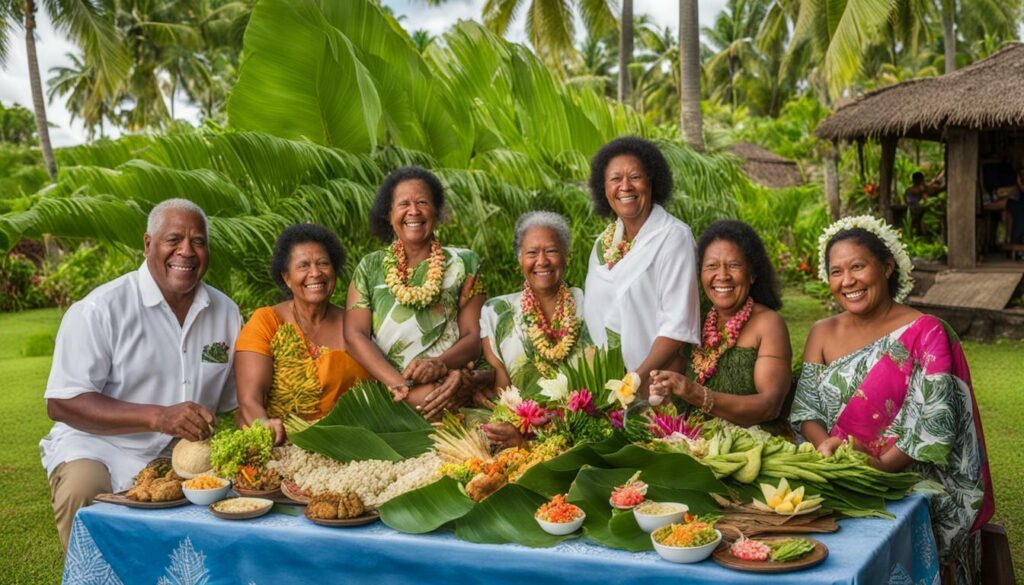
The Home Food Environment and Healthy Eating
The home food environment significantly impacts the dietary choices and perceptions of healthy eating among urban iTaukei mothers, reflecting the broader traditions of Fijian cuisine. In a study conducted by researchers, it was found that mothers played a crucial role in shaping food decisions within the household, especially during festive occasions.
The study revealed that traditional Fijian foods, such as kokoda (a dish made with raw fish marinated in lemon or lime juice and coconut milk) and lovo (meat and vegetables cooked in an underground oven), were cherished and enjoyed by the Fijian community.
Urban iTaukei mothers, in particular, recognized the cultural significance of these foods and their role in maintaining their cultural identity. They believed that preparing and sharing traditional Fijian dishes during festivities not only brought the family together but also passed down their cultural heritage to younger generations.
“Food is an integral part of our Fijian identity. It connects us to our ancestors and allows us to celebrate our cultural heritage,” expressed one of the mothers interviewed during the study.
However, the study also highlighted the challenges faced by urban iTaukei mothers in maintaining a healthy food environment for their families.
The increasing availability and affordability of processed and unhealthy foods have presented a dilemma for mothers who strive to balance tradition with the promotion of nutritious meals. Limited access to fresh fruits, vegetables, and seafood in urban areas further exacerbates the issue, resulting in a greater reliance on processed foods.
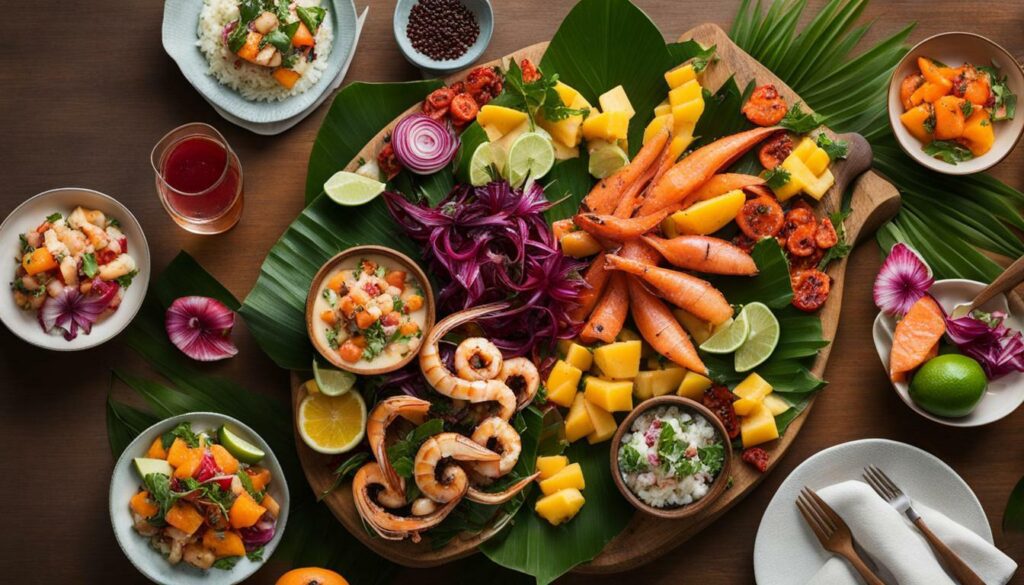
Traditional Fijian Dishes
To better understand the richness of Fijian cuisine, it is important to explore some of the traditional Fijian dishes that have been passed down through generations.
These dishes not only showcase the diverse flavours and techniques used in Fijian cooking but also reflect the cultural values and traditions of the Fijian people.
| Dish | Description |
|---|---|
| Kokoda | A marinated dish made with raw fish, coconut milk, lemon or lime juice, and various seasonings. It is a popular appetizer in Fiji. |
| Lovo | A traditional Fijian feast where meat, along with root vegetables and taro leaves, is cooked in an underground oven. It is a communal and celebratory way of cooking in Fiji. |
| Rourou | A traditional Fijian dish made with taro leaves cooked in coconut milk. It is often served as a side dish and is enjoyed for its rich and creamy flavour. |
The preservation and promotion of these traditional dishes play a vital role in maintaining the cultural heritage of Fiji and preserving the unique flavours and culinary traditions of the nation.
Targeting Healthful Nutrition Promotion
Targeted promotion of healthful nutrition is crucial in Fiji, and efforts should be made to preserve and promote traditional foods as a way to address nutritional challenges and improve the well-being of the population.
Traditional Fijian cuisine, with its rich variety of flavours and nutrient-dense ingredients, holds the potential to provide a sustainable and healthy dietary foundation for the nation.
One approach to promoting healthful nutrition in Fiji is through educational campaigns that emphasize the cultural and nutritional value of traditional foods. By showcasing the unique tastes and benefits of Fijian dishes, individuals can be encouraged to incorporate these foods into their daily meals.
Additionally, providing cooking classes and sharing traditional Fijian recipes can empower individuals to prepare these nutritious meals at home.
“Traditional Fijian cuisine, with its rich variety of flavours and nutrient-dense ingredients, holds the potential to provide a sustainable and healthy dietary foundation for the nation.”
An important aspect of healthful nutrition promotion is fostering partnerships with local farmers and food producers. By supporting and promoting the cultivation of traditional crops and the production of traditional Fijian foods, the availability and accessibility of these nutritious options can increase throughout the country.
This not only promotes healthier eating habits but also supports the local economy and preserves traditional agricultural practices.
To encourage the consumption of traditional foods, it is also essential to address the affordability and availability of these ingredients. By working closely with policymakers and stakeholders, initiatives can be developed to make traditional foods more accessible and affordable to a wider population. This may include implementing policies that provide incentives for local farmers to grow traditional crops or subsidizing the cost of traditional ingredients.
By targeting healthful nutrition promotion in Fiji and focusing on the preservation and promotion of traditional foods, the nation can take significant steps towards overcoming nutritional challenges and improving the overall well-being of its people.
With the cultural significance and nutritional value of Fijian cuisine, embracing traditional foods can have a transformative impact on the health and vitality of the population.
| Benefits of Targeted Nutrition Promotion in Fiji | Approaches |
|---|---|
| Improved health and well-being | Educational campaigns emphasizing cultural and nutritional value |
| Promotion of sustainable agriculture | Partnerships with local farmers and food producers |
| Increased accessibility and affordability | Policies to support local farmers and subsidize traditional ingredients |
Future Directions and Initiatives
Future directions and initiatives should focus on preserving and promoting the rich history of food in Fiji, while also recognizing the importance of Fijian national food as a cultural heritage. A key aspect of preserving the history of food in Fiji is through documentation and research.
Efforts should be made to collect and record traditional recipes, cooking techniques, and stories associated with Fijian cuisine. This information can be shared through books, online platforms, and community events, ensuring that future generations have access to the knowledge and traditions of their ancestors.
In addition to documentation, educational programs and initiatives should be implemented to raise awareness and appreciation for Fijian national food. This can be done through school curriculums, cooking classes, and cultural workshops. By educating the younger generations about the importance of Fijian cuisine, it can be preserved and celebrated for years to come.
Collaboration between government agencies, community organizations, and local businesses is crucial in promoting Fijian national food. Initiatives such as food festivals, culinary competitions, and food tourism can showcase the diversity and uniqueness of Fijian cuisine to both locals and international visitors.
These events can not only promote local businesses and products but also create opportunities for cultural exchange and understanding.
The Importance of Fijian National Food
Fijian national food represents more than just a collection of dishes; it reflects the identity, history, and traditions of the Fijian people. It is a testament to their resilience, resourcefulness, and deep connection with the land. Preserving and promoting Fijian national food is not only about preserving flavours and recipes but also about preserving cultural heritage and contributing to the overall well-being of the Fijian community.
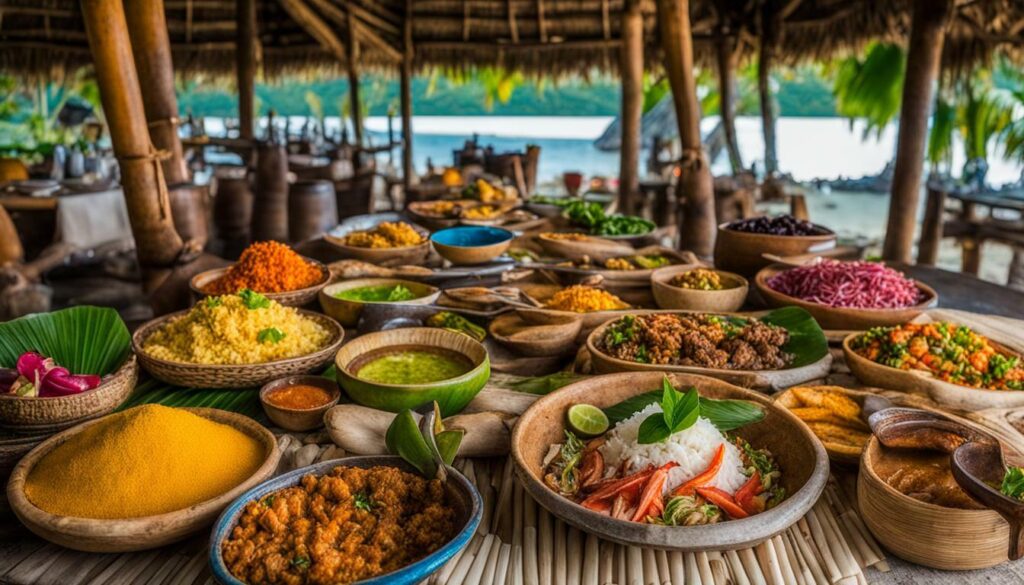
| Key Initiatives | Implementation Strategies |
|---|---|
| Documentation and Research | Collaborate with local communities, chefs, and historians to collect and record traditional recipes, cooking techniques, and stories associated with Fijian cuisine. Publish books, create online platforms, and organize workshops to share this information. |
| Educational Programs | Integrate Fijian cuisine and culinary traditions into school curriculums. Offer cooking classes and cultural workshops to educate the younger generations about the importance of Fijian national food. |
| Promotional Events | Organize food festivals, culinary competitions, and food tourism activities to showcase the diversity and uniqueness of Fijian cuisine. Collaborate with government agencies, community organizations, and local businesses to make these events successful. |
By implementing these future directions and initiatives, Fiji can ensure that its rich history of food is preserved, celebrated, and passed down to future generations.
Fijian national food can continue to be a source of pride, identity, and enjoyment for the Fijian community, while also contributing to the cultural heritage and overall well-being of the nation.
Conclusion
In conclusion, the past and present diets of Fiji provide a fascinating journey through history, highlighting the cultural importance of Fijian cuisine, national food, and traditional recipes. The exploration of Fijian culinary evolution reveals the rich heritage of traditional foods that have shaped the nation’s culinary culture for centuries. From the influence of social changes and identity to the dietary behaviours of the population, the significance of food in Fiji extends beyond its nutritional value.
However, the challenges of malnutrition pose a threat to the health of the population, as dietary changes have led to a shift from traditional diets to modern food choices.
Traditional Fijian meals and recipes, still cherished today, offer a glimpse into the cultural heritage and traditions of the Fijian community.
The role of mothers as sociocultural agents in shaping food decisions, particularly during festive occasions, further emphasizes the importance of food in Fijian society.
The home food environment plays a crucial role in promoting healthy eating choices, and there is a need for targeted promotion of healthful nutrition in Fiji.
Preserving and promoting traditional foods is essential to improving the overall health of the population and preserving the cultural significance of Fijian cuisine.
As we look towards the future, initiatives that prioritize the preservation and promotion of past and present diets of Fiji are crucial in ensuring the continued celebration and enjoyment of Fijian national food.
Through an exploration of history, culture, and identity, the past and present diets of Fiji offer valuable insights into the nation’s culinary heritage.
By understanding the significance of Fijian cuisine, national food, and traditional recipes, we can appreciate the diversity and richness that food brings to the Fijian community.
Let us continue to embrace and celebrate the vibrant flavours and culinary traditions of Fiji, ensuring their preservation for generations to come.
FAQ
How can foodways help us understand social changes and identity in Fiji’s archaeological past?
Foodways provide insights into the relationship between cuisine, material culture, and domestic archaeological features, allowing us to understand how food choices and preparation methods have evolved over time, reflecting social changes and cultural identity in Fiji.
What factors influence the dietary behaviors of children, adolescents, and women in Fiji?
The dietary behaviors of individuals in Fiji are influenced by a combination of individual, social, and food environment factors. These include personal preferences, cultural norms, peer influence, accessibility to healthy or unhealthy food options, and advertising and marketing of processed foods.
How has the shift from traditional diets to unhealthy, processed foods affected the population in Fiji?
The shift from traditional diets to unhealthy, processed foods has resulted in multiple burdens of malnutrition in the population, including undernutrition, overnutrition, and micronutrient deficiencies. This has contributed to health issues such as obesity, diabetes, and cardiovascular diseases.
What is the role of urban iTaukei mothers in shaping food decisions in Fiji?
Urban iTaukei mothers play a significant role as sociocultural agents in shaping food decisions in Fiji. They pass down cultural traditions related to food, influence food choices within the home, and contribute to the perception of healthy eating among their families and communities.
How does the home food environment influence healthy eating choices in Fiji?
The home food environment, including the availability, accessibility, and affordability of healthy foods, greatly affects the dietary choices of individuals in Fiji. It is crucial to create an environment that promotes and supports healthful nutrition to improve the overall health of the population.
What are the future directions and initiatives to preserve and promote the past and present diets of Fiji?
Future directions and initiatives to preserve and promote the past and present diets of Fiji include educating the population about the cultural significance and health benefits of traditional foods, supporting local farming and sustainable food practices, and creating policies that prioritize the preservation of Fijian cuisine.
Source Links
- https://journals.lib.washington.edu/index.php/JIPA/article/view/15000/12532
- https://www.ncbi.nlm.nih.gov/pmc/articles/PMC10445140/
- https://www.mdpi.com/2072-6643/15/18/3875



